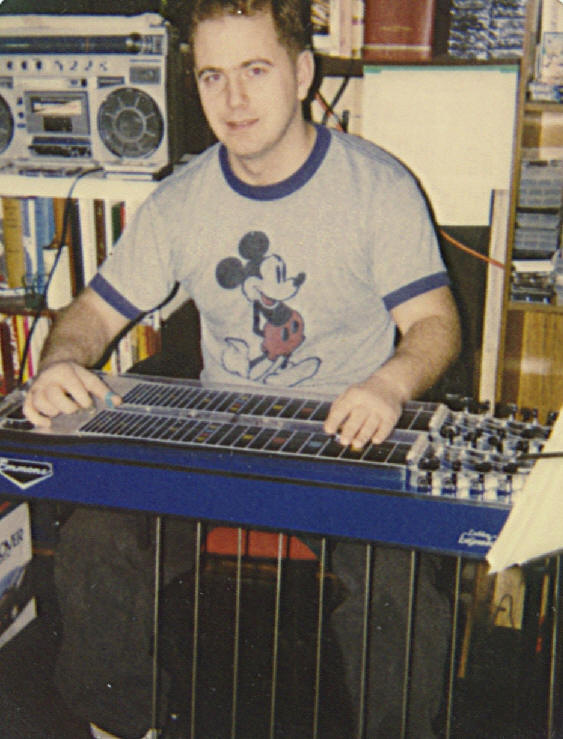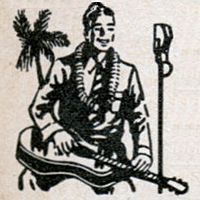
What is a half-stop? It is a mechanically derived increase in pressure which the knee “feels” when you depress the knee lever to the predetermined point. This allows you to play a note in correct pitch in between the total travel of a knee lever. For example: On string 2 open for the E9th we use a D# note. Lowering the string a whole tone gives us a C#. However, if we would like to obtain a D note, which has so many wonderful applications that no player should do without it, then we need a half-stop mechanism of some sort.
My favorite half-stop is an independent half-stop assembly kit (for Sho-Buds) (it comes with everything you need, except an ice-cold glass of fresh lemonade). I like the stand-alone unit because you have complete control and can adjust the amount of tension that you feel at the half-stop point. I don't like hard knees. Too much pressure (resistance) on the knees will interfere with your working performance. Knee levers and pedals ought to be comfortable, loose, freely able to move, and without a cumbersome need to press hard. Never buy a pedal steel unless it has fully adjustable knee levers, including the vertical knee.
So the main reason I like a stand-alone half-stop assembly is because you can set the half-stop tension as soft as you'd like. I set it just hard enough to where it's not causing any problems. If it does cause trouble, increased the tension a little bit. It depends also on how big and strong your leg is. If you have a heavy leg, or tend to lean your leg into the knee lever and throw off your tuning while performing, you might consider increasing the tension of both your knee lever and half-stop. I've never ordered a pedal steel yet that didn't require some amount of babying, minor adjustments and getting some small hand-tools out. That's a normal occurrence, so don't get upset when your guitar comes a bit out of whack and out of tune. Most builders won't take the time, to keep their guitars cost effective I guess, to make all the minor changes. Yet, in a way I prefer it that way, because then I can adjust it the exact way I like it.
If you are familiar with Rittenberry steel guitars (I am very happy with mine, a S-10 on a 3/4 black mica body), then you know that Tim has an exclusive nifty little feature that allows the player to set their half-stops simply by using the standard hex-nut tuner. The little window for this adjustment is adjacent to the regular hex-nuts. This prevents having to turn the guitar over and get your tools out to adjust your half stops. The only drawback is that it adds additional pull to your knee, which effectively takes away one of your copedent changes. So if you're used to, let's say, raising string 7 one half-tone along with lowering string 2 one full-tone on the same knee-lever, effectively you'll have the drag of 3 pulls now with the half-stop adjustment for string 2. An alternative is to use the lowering of string 9 a half-tone as a clever means of providing a half-stop for string 2. By doing it this way, you're not adding any additional pressure to the knee levers without gaining a chord change at least. The only drawback is that lowering the 9th string doesn't have as firm a half-stop feel as Tim's built-in mechanism.
I presently am using the lowering of string 9 to get my half-stop, but I may
put it back the other way, because I like that firm half-stop feeling. Lloyd
Green extensively uses the half-stop on the 2nd string, and I recommend that
every player do what it takes to make sure you have a good working half-stop
on string 2.
Helpful Information On Guitar Setups
Tommy White also uses a half-stop on string 5, but I don't. I do lower string 5 a whole tone with my right-knee-left (RKL), which is how Tommy does it also. My Rittenberry guitar has a half-stop pull for the 5th string, but I backed off the hex-nut completely and don't use it at all, because I didn't like the additional tight knee-lever tension it caused. I lower string 5 and raise string one a whole tone on the RKL. That arrangement irritates me a bit, because I have to make sure to silence string 5 with my finger before raising string one along with the B pedal, or it will sound sour. I love raising string 6 a half tone (B pedal) along with string 1 a whole tone. It's a classic pedal steel sound, but lowering 5 doesn't work with it. Tommy White actually raises the first string a whole tone with his 4th foot pedal, which I couldn't get used to. I have Tommy's setup, except I removed the 4th foot pedal, because It kept interfering with the C pedal.
Also, Tommy uses the Jimmy Day (CBA) floor pedal arrangement, but I use the Buddy Emmons (ABC) setup. Lloyd uses the ABC setup as well. Jeff Newman used the CBA setup, as did Weldon Myrick. So you'll often hear pedal steel players refer to the “Emmons setup” or “Day setup.”
If your setup is fairly simple, like Lloyd Green's, then you won't have a problem with tight knee levers. In recent years I have removed my 4th floor pedal on my Rittenberry, because it kept interfering with me pressing the C pedal. On my Sho-Buds (a D-10 and a S-10), I just use Lloyd's setup, except I raise string 1 a whole tone. It's best to only raise string 1 a half tone, because then you can simply use a bar slant (with the pedal) to get the same sound, but you'll also have the addition of the cool stuff Lloyd plays using string one raised a half tone. I only raise string 1 a whole tone because that's what I am used to, and I like the feel I get while performing. It's important that you feel good while playing, when you're energy is high and you're really getting into a track or song. That's why Lloyd doesn't use compensators on string 7, because he doesn't like the feel while performing, and I am of the same opinion. I tune string 7 to sound in tune with string 8 lowered and string 5, because I use that string compensation more often. Like Lloyd, I just reverse slant the bar a bit to compensate for the off sound when playing string 7 along with strings 5 and 6.
Lloyd Green Tuning Seminar
(MP3, 21:54 minutes long, Texas Steel Show, October 1992)
On my D-10 Pro II Sho-Bud, the lowering of the third string on the C6th neck from C to B is actually used to create a half-stop “feel” for the E9th second string. By manipulating the rod/hole positions in the changer fingers and undercarriage cross-shafts, I've never had a problem getting a nice half-stop on my guitars. But I'm sure there are exceptions, and at best your working with some amount of luck.
Every E9th pedal steel guitar player ought to lower the second string a full tone, and a half tone as well. Many of the older ShoBud S-10 guitars, and D-10's, didn't have a good half-stop mechanism on them. For years I never had a good half-stop on my steels and I learned to play without lowering string two a half-tone. That was really bad thing I tolerated, because I greatly limited my learning ability, repertoire and skills. So make sure you have a good working half-stop for your 2nd (D#) string, which lowers it to a (D), and then down to (C#). This C# wonderfully combines in unison with the C# when pedal A or C is depressed, which gives you some really nice sounds to raise a few eyebrows in the audience (as Jeff Newman used to say... I sure miss Jeff. He taught me how to perform block picking).
Buddy Emmons taught me later on that you can play an entire song on one fret on the E9th (without ever moving the bar at all). He is right! You have all twelve notes of a chromatic scale on one fret. Buddy calls this “LINEAR.” But you must have the half-stop on the 2nd string in order to complete the scale. The second string typically uses a .015-inch gauge stainless steel string. Buddy says the E9th is more LINEAR than the C6th, obviously, because on the C6th you have to move your bar back-and-forth at least two frets to complete the chord scale. That's very interesting. Both tunings are beautiful to learn and play. Please don't avoid one over the other. Learning lap steel C6th opened my eyes to understand many aspects about both the C6th and E9th pedal steel guitar. I recommend ordered “The Big Book” by Jerry Byrd from Scotty's Music in St. Louis, a comprehensive steel guitar course. I am confident that you will love it as I still still do. It is priceless.
Jeffran College
(Great instruction for E9th and C6th pedal steel guitar)
You CAN get both the half-stop on string 2 and the half-drop change on string 9 working together properly. Here's how to do it. My S-10 Sho-Bud is a Triple Raise/Double Lower. You should get used to using that terminology when describing pedal steel guitars. It's real easy. Triple Raise means that I have three holes, or provisions on the changer finger to raise a rod. A Double Lower means that I can use up to two pull rods to lower a string. I think it is the New MSA series who pioneered the new quadruple Raise and Lower. Cool!!! My old Pro-II Sho-Bud has a Double Raise/ Single Lower changer. That's old beautiful stuff! Any older and I'd be drilling a hole through the body and pulling the strings with a coat hanger attached to the floor pedals. Yeah, that's how it all got started. No kidding! You can tell how many Raises or Lowers your guitar has by counting the rod holes in any of the individual fingers.
Ok, if you're having difficulties getting strings 2 and 9 to coordinate
together, do this... Look at the fingers. If you have a Double Lower like
mine, you've got two possible holes to use. Your bellcrank shaft should have
about 5 holes. So that gives you 10 possible bellcrank-to-finger mechanical
ratio combinations. I recommend using the bottom hole first (which is the
hole farthest away from the fretboard). The bell-crank slides onto the
cross-shaft. My cross-shafts are the hex (6-sided) type. Try the different
hole positions. After you move the rods, check to see if you can get your
9th string to lower to where it should be. If you're getting closer, move to
the next hole in the bellcrank. If it doesn't work. Try to use the other
hole in the finger, in the changer.
Some Helpful Steel Guitar Tips
Also, I use hair-clipper oil, which is a very light grade, odorless, dust-free oil. I love that oil. Don't go hogwild with the oil. Put several drops between your changer fingers up top after changing your strings, Move all the pedals and knees and work the oil into the mechanisms. Place a few drops of oil at every metal-to-metal contact place. Do NOT put oil on plastic parts, even if they contact with metal parts, as the oil might weaken or soften the plastic over time. Wipe off any excess oil. I use Old English furniture oil to protect the old wood necks and body on my Sho-Buds. I chrome the legs and chrome parts with Brasso metal polish, but there are numerous others that are fine. I didn't but this for any particular reason. It was just available at the store.
I adjusted my guitar today, which has been needing attention for the last year. I got tired of having to slightly slant my bar because the string 4 wouldn't tune down low enough to -10 degrees Eb (tempered tuning). It's just a matter of getting the right length rods, replacing bad hex-keys that pop off while performing, making sure all the rods and parts are aligned neatly without interfering or binding with other parts. Make sure all the set screws are tight, but not so tight that you strip them. Always use a hand wrench when tightening anything, so you don't strip it out. I like the long Allen wrenches, which I think are easier to access the setscrews. Plus you get a lot more leverage. If you have a Sho-Bud with hexagonal (6-sided) cross-shafts, the parts are not interchangeable with the round cross-shaft system.
Also, if you have the newer squared knee levers, you should have setscrews in your knee levers, so you can adjust the leg position. My advice is to NEVER buy any guitar that is so old that the knee levers are not ADJUSTABLE!!!
But if you have a guitar like that, go down to your local hardware store and buy 1-inch foam pipe insulation. Install it over your knee levers to reduce the gap between your knees. The foam is soft and comfortable. You might need to wrap a papertowel around the knee first, and then put the insulation over it. Use can use some tape or rubberbands to secure the foam. Since they are very old guitars, you have to work with what you have.
Also, due to my nerve damage in my spinal cord, I have pain in my left knee while playing, so I bought a knee-support at my local grocery-store pharmacy, which works great. It is made by ACE, and has two Velcro straps, one above and one below the knee. The knee-support is thin, but comfortable, and completely covers the leg on all sides. I can work the LKL (left knee left) and LKR (left knee right), and LKV (left knee vertical) without feeling pain.
Also, there are complete knee lever kits available for the Sho-Buds (here's their main website). Make sure you specify whether you have round or hex-shaped cross-shafts (or parts won't fit). A half-stop complete assembly runs around $66 bucks, and inserts with just two screws and a little adjustment to set the amount of tension you want. Don't be afraid to screw a hole into your wooden body guitar, they'll go right in. Just make sure that you've got everything adjusted and laid out, so you have a pretty good idea of where you want to mount the base. If you make a mistake, just move over a little and try it again. The underside of my Sho-Bud looks like Swiss Cheese from previous owners. Literally, there's about 25-30 holes in it!!! It'll feel really good when you get it all done and then play along with your favorite Country singer.
And definitely put some new strings on the guitar. You know, I really like the Ernie Ball #2504 E9th Stainless Pedal Steel strings. They give you a .010" string for string three, which I hear never breaks. The standard .011" is known to break quite often, depending how much you perform. So the .010 gauge string works nice I think. Lloyd Green uses an .0115" gauge string, perhaps for more strength and better tone (Lloyd has the best tone of any steel player, bar none). I hear so many players who sound like they're playing under a pile of leaves. Ernie Ball also give you a .022" wound for the 6th string, which is what Lloyd Green uses. I like the wound much better than the plain. It's more expressive I think. It has a more vocal sound, more presence I think. The only problem is that my Rittenberry S-10's split-tuning won't work with a 22" wound. It works fine with a plain string. I haven't tried all the string brands. Each string brand has different characteristics, evidenced when you change your strings and have to readjust your hex-nuts.
Despite the loss of my split-tuning, I just use the .022 wound anyway. I can still lower string 6 a whole tone just fine, but I don't use the split-tuning on string 6 (the string won't raise high enough). I generally do what Lloyd does to get that chord, by doing a forward bar slant. To do this, say on the 10th fret, you start by pressing both A and B pedals down on strings 6,5 and 4. Then you slide the back of the bar down across fret 9 on string 6, letting off pedal B. The tip of your bar should now be exactly between string 4 and 5 on fret 10, with only the A pedal depressed (pushed down). This is the same chord you'd get by raising string 7 a half tone, or by using a split-tuning on string 6.

Take someone to the islands today with your music!
John 20:31, “But
these are written, that ye might believe that Jesus is the Christ,
the
Son of God; and that believing ye might have life through his name.”

